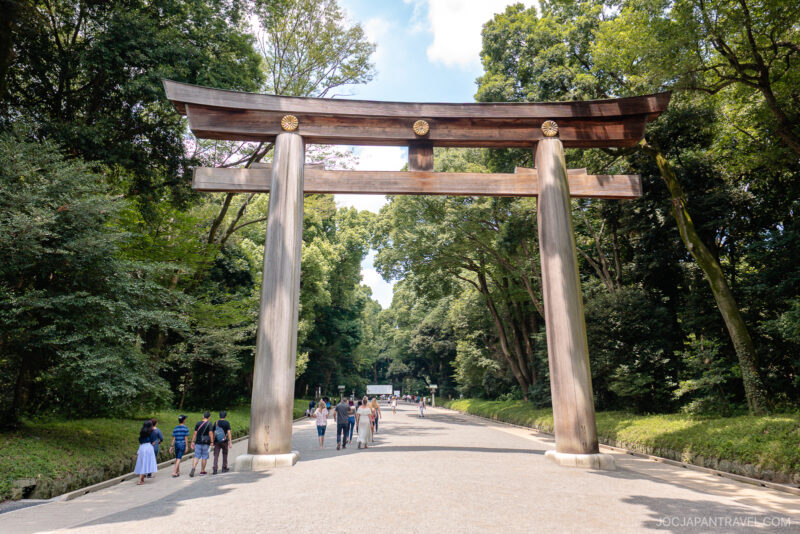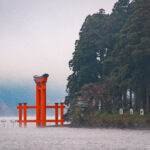This post may contain affiliate links. Please read our disclosure policy.
Meiji Jingu Shrine is Tokyo’s most iconic Shinto shrine, surrounded by a lush hand-planted forest where visitors can reflect, pray, and enjoy nature in the heart of the city.

What Makes Meiji Jingu Special
Meiji Jingu Shrine was built in 1920 to honor Emperor Meiji and Empress Shoken. Although the original buildings were destroyed during World War II, they were faithfully rebuilt in 1958 with support from the public. Today, the shrine is one of Japan’s most visited religious sites, welcoming millions each New Year for Hatsumode, the first shrine visit of the year.
What makes Meiji Jingu unique is its simplicity. Unlike temples filled with gold or bold colors, the shrine’s wooden Torii gates, wide gravel paths, and towering trees create a calm atmosphere. Walking here feels like stepping away from Tokyo’s nonstop energy into a place of balance and respect.
Meiji Jingu Inner Garden

Just inside the first Torii gate is the Inner Garden, once loved by Emperor Meiji and Empress Shoken. Admission is ¥500, and it’s worth it. The iris garden is the highlight in early summer, with purple and white blooms filling the pathways. Even when we visited in July after the peak, the pond, shaded paths, and teahouse made it a refreshing stop.
Don’t miss:
- Kiyomasa’s Well – A spring-fed well believed to have spiritual energy.
- Nan-chi Pond – A quiet spot with koi fish and water lilies.
- Kakuun-tei – A teahouse built by Emperor Meiji for Empress Shoken.
Walking the Shrine Grounds

Passing through the 12-meter-tall Otorii gate feels like entering another world. The pathway is wide and stroller-friendly, lined with sake barrels from brewers across Japan and wine barrels from France, symbolizing both tradition and modernization during Emperor Meiji’s reign.
At the main hall, visitors follow simple Shinto etiquette: toss a coin into the offertory box, bow twice, clap twice, make a wish, and bow once more. Signs in English make it easy for first-time visitors to join respectfully.
The Meiji Jingu Museum and Treasure House
For those who want to learn more, the Meiji Jingu Museum opened in 2019 and displays artifacts connected to the imperial couple. Nearby, the Homotsuden (Treasure House), built in 1921, preserves personal belongings of the Emperor and Empress. Both add context to the spiritual and cultural role of the shrine.
Camphor Trees and Ema Wishes

In the shrine courtyard stand two massive camphor trees tied with a sacred rope. Couples often visit here to pray for strong and healthy relationships. Surrounding racks hold thousands of ema—small wooden plaques where visitors write wishes or prayers.
Seasonal Highlights and Events
Meiji Jingu is open year-round, but timing your visit adds a special touch:
- June–July: Iris bloom in the Inner Garden
- November 3: Grand Autumn Festival celebrating Emperor Meiji’s birthday
- January 1–3: Hatsumode, when more than 3 million people visit
Even in the summer heat, the forest canopy keeps the walk shaded and cool, so it’s one of the most comfortable outdoor spots in Tokyo.
How to Get to Meiji Jingu Shrine
Meiji Jingu sits between Harajuku and Yoyogi Park in Shibuya. It is easy to reach by train, on foot, or by taxi.
By Train
- Harajuku Station (JR Yamanote Line) – 1 minute from Omotesando Exit
- Meiji-jingumae Station (Tokyo Metro Chiyoda and Fukutoshin) – 1 to 3 minutes
- Yoyogi Station (JR and Toei Oedo) – about 10 to 15 minutes
By Taxi
From Shibuya or Shinjuku, rides take 5 to 10 minutes. Fares are usually ¥1,000 to ¥1,500 depending on traffic.
Accessibility
Main approaches are wide and mostly flat gravel. Strollers and wheelchairs are manageable. The museum has elevators. Parts of the Inner Garden have steps and uneven paths.
Pro Tip: Enter at Harajuku Gate before 9 a.m. for fewer crowds and easier photos at the first Torii.
Is Meiji Jingu Worth Visiting?

Yes, Meiji Jingu is one of Tokyo’s must-visit spots. It combines history, spirituality, and natural beauty in a way that few places in the city can. Whether you’re praying, touring with family, or just seeking a calm break from the urban rush, Meiji Jingu offers an unforgettable experience.
Yes, Meiji Jingu is one of Tokyo’s must-visit spots. It combines history, spirituality, and natural beauty in a way that few places in the city can. Visitors can pray, explore with family, or enjoy a peaceful pause from the city, and it’s an experience you won’t forget.
More to Explore Nearby
After strolling through the peaceful forest paths of Meiji Jingu Shrine, explore nearby streets filled with culture, style, and energy.
- Takeshita Street – Step into Harajuku’s world of pop fashion, sweet treats, and youth culture just minutes from the shrine’s entrance.
- Omotesando – Walk the tree-lined avenue known for high-end architecture, luxury boutiques, and elegant cafes with Tokyo flair.
- Shibuya Center Gai – Just one train stop away, this vibrant street pulses with fashion, nightlife, and late-night food.
- Tokyo Metropolitan Government Building Observation Decks – Catch free panoramic views of Tokyo from this sleek observatory in nearby Shinjuku.




